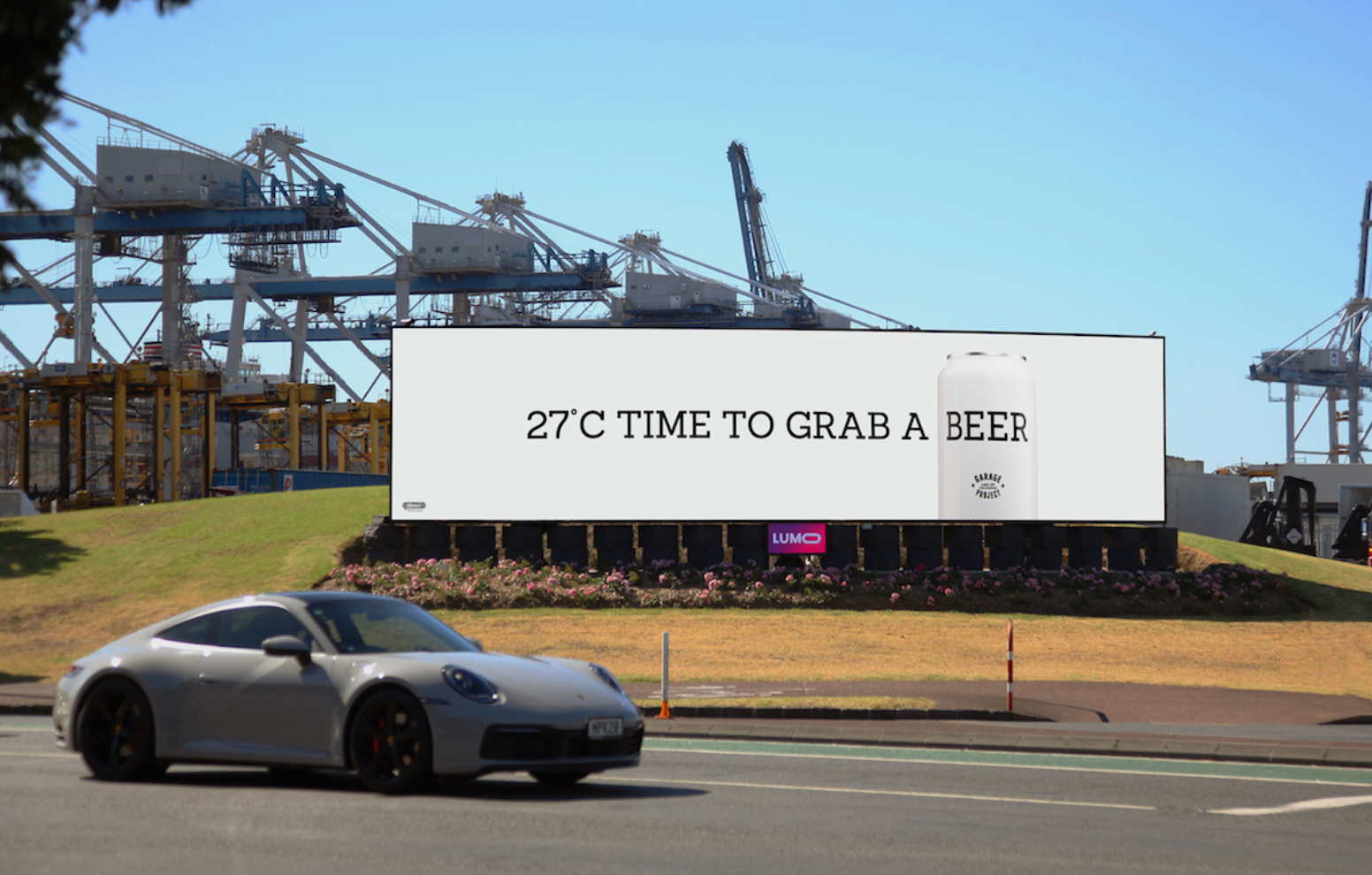Car ads ideas: How to win on brand

Even when facing down significant challenges like slower economic growth and semiconductor shortages, the automotive industry is continuing to see robust growth — which is why companies are continuing to invest in the sector.
Take the United States, which also happens to be the third largest producer of cars. In 2022, the US spent an estimated $48.4 billionOpens in new tab on automotive research and development, making up 39% of global R&D spending.
That’s a massive investment.
But we should also point out that the car industry is incredibly competitive. 🏁
Smart car manufacturers know that in this market, innovative designs or technology are only one facet of what makes a particular brand or model appealing to their audience.
Equally important is how cars are advertised and manufactured.
Compelling advertising in the automotive industry doesn’t just highlight a vehicle’s top selling points, it also communicates a sense of aspiration and affinity for a certain way of living.
Cars represent far more in the eyes of consumers than the ability to get from A to B. As well as symbolizing broad ideas such as freedom, mobility, and adventure, different car brands and models have become important markers of status and lifestyle. This makes brand management an especially effective strategy to attract consumers and build lifelong preferences.
So, what does effective advertising look like for a car brand, and how can you measure the success of your branding efforts?
Sign up to Shorts
For fortnightly brand insights, stories and goodness that'll help you win (we promise).
Why brand is so important when it comes to car purchasing decisions 💡
For a consumer to consider your brand for a purchase, they have to be aware of you in the first place. Thanks to our mates at TRAOpens in new tab, we know that once your brand is in someone's consideration set, you're 6 to 10x more likely to be chosen in a purchasing decision.
But unlike product categories such as apparel or footwear, buying a car is rarely an impulse decision (unless you’re in the running to star in the next series of The Real Housewives). It’s a big ticket purchase that most people make once every few years, or possibly less in some markets. Plus, the automotive industry is a crowded market with an overwhelming number of options. This makes it even more likely that consumers will only consider car brands they already have an affinity with.
Many consumers aren’t aware (or are indifferent to) the ins and outs of different car models or the latest technology. But they do know what ideas or values are associated with different car brands.
For example, you don’t have to know much about cars to know that a Ford F-150 can represent rugged masculinity — a very different persona than someone who would drive a compact car like a Toyota Corolla. This is the result of years of careful branding initiatives that have tied car choices closely to our perceived identity and lifestyle.
So, to have a realistic shot at making a consumer’s shortlist of consideration, you need to begin building brand awareness and recognition with your core values…yesterday.
But remember: It’s never too late to start. ⏰
5 car ad examples that are crushing brand marketing 🚗
1. Polestar: No Compromises

Striving to position itself as the premium electric vehicle option, Polestar’s 2022 Super Bowl commercial went for an extremely paired-back visual style that let its high-performance design do all the talking.
Instead of the punchy graphics and revving engines that we’re used to seeing in car commercials, this Apple-esque approach put Polestar’s brand values front and center, like “no greenwashing” and “no empty promises.”
The 30-second ad even managed to slip in a couple of subtle digs at rival car brands, including Tesla (“no conquering Mars”) and VM (“no dieselgate”).
The message is clear: As a standalone, EV-only brand, Polestar can be trusted to deliver on its sustainability and performance commitments.
2. Mini Cooper: It’s a MINI adventure
Thanks to its cameo in the comedy caper film The Italian Job, Mini Cooper already had an association with high stakes and going places that no other car could go. The “It’s a MINI adventure” commercial series from the early 2000s put the car at the center of the action by depicting Mini Coopers coming to the rescue in all kinds of absurd scenarios, from the zombie apocalypse to a Martian invasion of London (yes, really — see above).
Although recent ads from this series are a little more pedestrian, they continue to reinforce the image of the Mini Cooper as the small but mighty car capable of handling whatever the world throws at it (even aliens).
3. 1987 Ford vs. Chevy
The Ford vs. Chevy advertising battle is one of the most iconic in the automobile industry, with the rival car brands taking shots at each other over several decades.
This 1987 Ford F250 commercial demonstrated the model’s powerful V8 engine by towing a Chevy and a Dodge–its biggest competitors–up a mountain. Chevy retaliated with an ad demonstrating not only the ability to tow a Ford up a mountain — but also towing away the entire mountain itself. The playful nature of these brands competing for market share has resulted in more consumer attention being paid to this category, with Chevy and Ford currently neck and neck in global sales, according to StatistaOpens in new tab.
4. Rolls-Royce: “There’s really no magic about it”
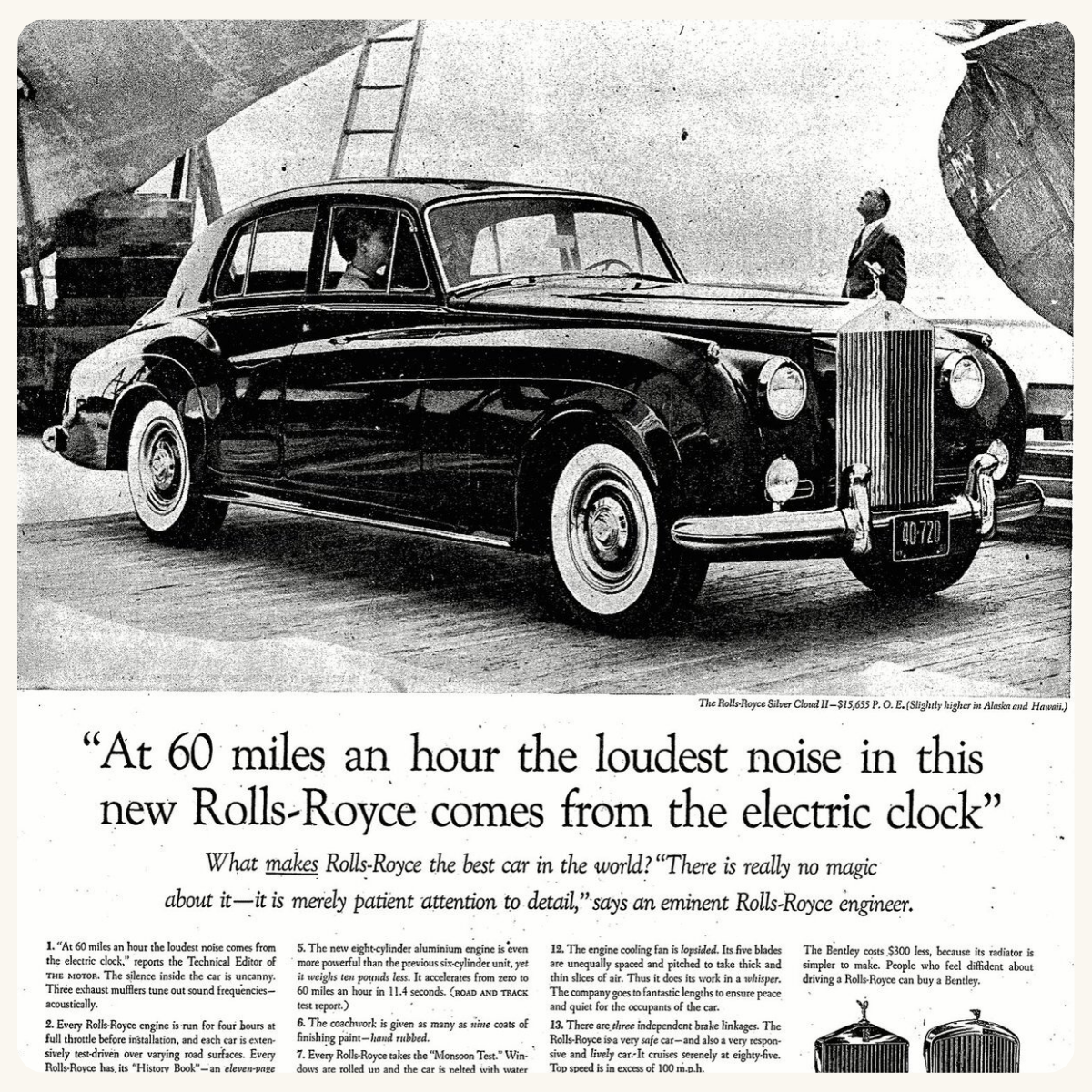
Rolls-Royce has long held the hotly-contested label as the champagne of the vehicle industry. To maintain market share in this sub-category, it’s not enough to create something that looks sleek and luxurious; to their highly discerning target customer, it also has to perform.
The idea of prestige performance has been honed by a long heritage of product-focused ads going back to the 1950s. David Ogilvy’s now-iconic 1957 newspaper ad used evocative copy both to describe its cutting-edge engineering and bring the experience of driving a Rolls-Royce to life: “At 60 miles an hour, the loudest noise in this new Rolls-Royce comes from the electric clock.”
Did it work? Their entire U.S. inventory sold out within weeks, so you be the judge!
5. Porsche: Nobody’s perfect

It’s often the simplest ads that end up being the most effective. Porsche’s faux modesty in this 1983 print ad celebrating their (almost) runaway victory at Le Man is a classy call-out of their prowess at engineering. By capitalizing on their success at one of the world’s toughest and most iconic endurance races, there’s zero need for Porsche to dress up this ad with loud copy or even any visuals — their stellar performance does all the work for them.
How to measure the impact of car ads on your target market 🤔
So, how can you emulate the car brands above and create compelling brand initiatives with real staying power? It all starts with your ability to measure what consumers think and feel about your brand — and your competitors.
To make informed decisions about your branding strategy, you need to know which branding efforts are landing with your target audience. The question is: How?
Thanks to Tracksuit, it’s never been easier for car brands to understand how their brand is perceived by consumers in their category. Our purpose-built platform dashboard enables you to dive deep into brand tracking with multiple tools views designed to analyze every facet of your brand:
Imagery view
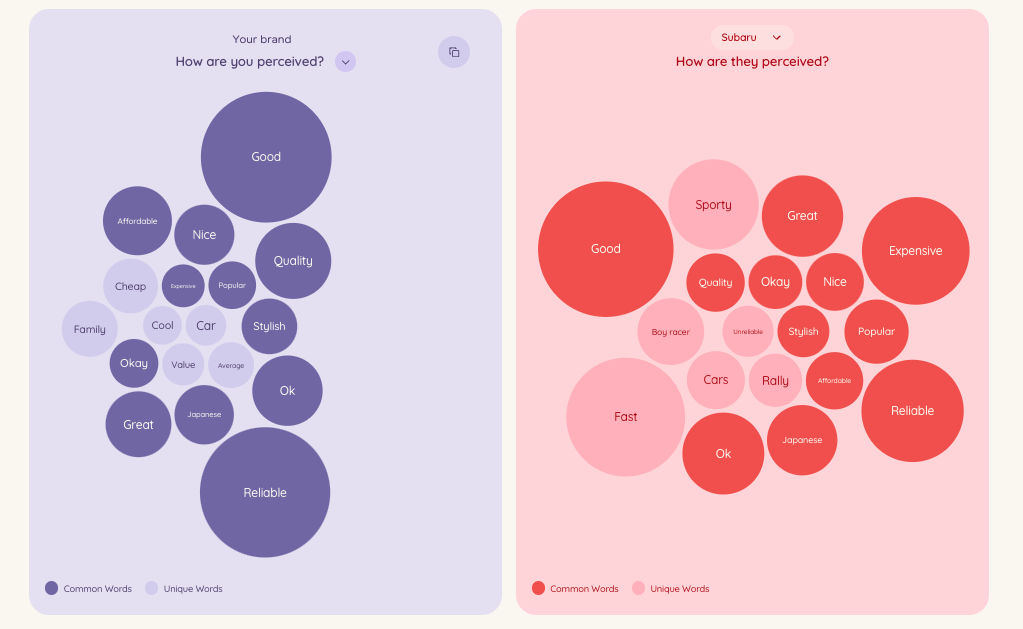
Non-US data shown.
Our imagery tool view visualizes the messages and ideas that are at the forefront of consumer’s minds when they think about you and your competitors. It’s a cumulative display of all of your brand building efforts, starting from when you began brand tracking. This makes it possible to measure how long it takes for brand messaging to take hold with consumers, such as after you’ve launched a new campaign.
Conversion view

Non-US data shown.
With funnel conversion data, you can take a much more expansive view of how consumers are progressing from Awareness to Usage. With the Conversion view, you can measure how effectively you are converting Top-of-Funnel consumers from Awareness to Consideration, while Bottom-of-Funnel Conversion measures how consumers are progressing from Consideration to Preference. Compare your data side-by-side to top competitors.
Statements view
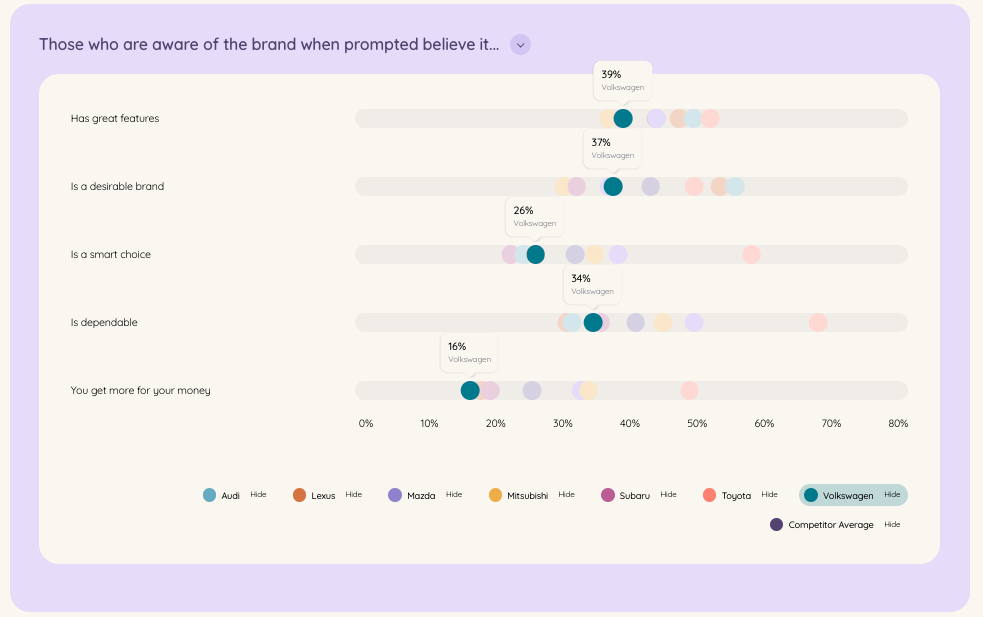
Non-US data shown.
The statements view curates consumers’ responses to five tailored messages that speak to your brand values and mission, so you can benchmark your brand’s performance against key competitors. It’s an intuitive way to measure whether your brand positioning efforts are succeeding, or if you’re losing ground to competing brands who are doing a better job at owning your value proposition.
Timeline view
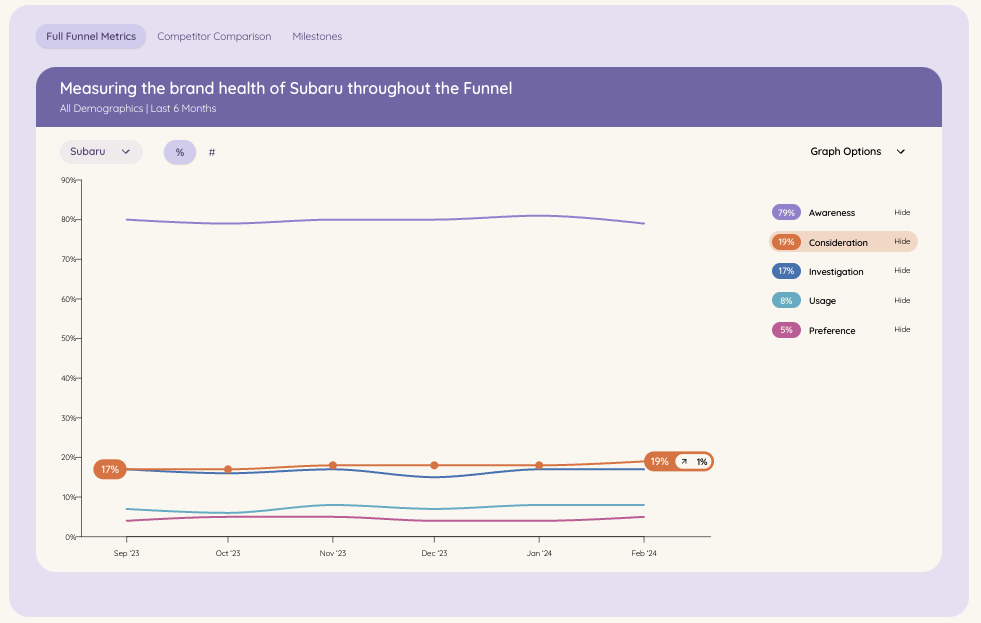
Non-US data shown.
Being able to view your brand health over time is critical to demonstrating your progress and adding context to your branding efforts. You can view both your data and that of your competitors according to specific funnel metrics, including Awareness, Consideration, Preference, and Use.
How Tracksuit helps car brands win 🏆
Find out whether your brand activity is working
Brand tracking can be notoriously difficult, as a strong brand is far more than how many consumers recognize your logo. Out of the millions of people who can identify a Mercedes-Benz car, for instance, only a fraction will consider buying one — and even less will follow through and make the purchase.
At Tracksuit, we're firm believers of the adage, What gets measured, gets managed. Tracksuit’s dashboard breaks down your brand’s profile into four intuitive metrics: Awareness, Consideration, Usage and Preference. These measuring capabilities pave the way for regular reporting and setting proper KPIs with confidence.
Plan what to do next
Once you have a solid overview of your car brand’s performance, you can start investing more time into understanding whether your efforts resonate with the right audience. Tracksuit’s Funnel and Profile tools enable you to track both the size and growth of your market over time, and how metrics like Awareness and Consideration vary between demographic indicators like gender, age, and income.
For example, if you can see that consumers earning more than $150,000 a year are more likely to consider your competitors over you, this is an indication that you need to reposition your brand to better attract this demographic.
Find out what competing car brands are doing
The saying ‘keep your friends close and your enemy closer’ definitely applies when it comes to branding. Keeping tabs on how your closest competitors are performing means you can identify vulnerabilities and opportunities to gain market share.
For example, if your car brand is outperforming competitors on the statement “I trust X brand,” this opens up a wealth of potential campaigns that capitalize on higher brand trust, allowing you to outmaneuver brands who have bigger market share or bigger budgets.
Grow your car brand (and marketing budget)
The toughest part of branding isn’t the execution or even measurement; it’s convincing the people upstairs that branding is worth investing in in the first place.
When so many brand initiatives lack a clear ROI, marketing and branding teams can face an uphill battle trying to justify their efforts. But with a system like Tracksuit, measuring the ROI of your brand efforts becomes a reality. Insights, like growth in brand awareness or the movement of consumers through your funnel, make for compelling case studies to present at the next board meeting when you’re making a pitch for a bigger brand budget. This allows you to pioneer bolder initiatives that offer more valuable insights, starting a powerful feedback loop that takes your car brand to greater heights.
With Tracksuit, your car brand will gain unparalleled visibility into your performance across the entire brand funnel, encompassing Awareness, Consideration, Usage, and Preference. Plus, you can intuitively compare your performance against competitors, ensuring you always stay ahead in this highly competitive industry.


